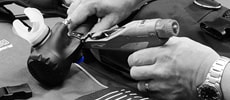Suppressible Warnings
by Martin Parker, AP Diving. Posted April 2016.
Low and High O2 warnings:
Please remember: oxygen warnings, low or high are not suppressible – we expect you to add gas, diluent or oxygen, to get the PPO2 within the normal life sustaining range (0.4 to 1.6 bar) or bailout to open circuit.
Other warnings are suppressible by pressing and holding the right button.
Cell Warnings:
Cell warnings have two levels of warnings: At 0.2 bar and 0.4 bar away from the average of the other two. At 0.2 bar the 1st level alarm is activated. Although this alarm is suppressible for 5 mins at a time, the appropriate action is to assess the cells: how do they react to gas addition, do they rise when oxygen is added? – if a cell doesn’t rise then it could well be current limited so start to lower the setpoint until all the cells are acting appropriately, right down below 1.0 bar if necessary. In the event that one cell deviated from the average of the other two by 0.4 bar, then the 2nd level alarm is activated and cannot be suppressed. You have to do something about it – ignoring it could cost you your life.
Lower the setpoint way down; take it to 0.7 bar if necessary. Flush with diluent, add a little oxygen, do all three cells behave appropriately to the gas change? – The ones that do change value appropriately are the ones to believe in.
Just because two cells agree, doesn’t mean they’re correct.
Cell warnings can occur for a number of reasons. Sometimes it can be trivial, for instance when you instigate a big change in PPO2, one cell might react more slowly than another and you might get a momentary alarm. An example of this would be when changing from the low setpoint to the high.
But, usually it is not trivial and needs your attention.
Cell warnings are the catchall. It is telling you there is something wrong and your EARLY assessment and monitoring is required. Just ignoring or suppressing it has cost lives.
The PPO2 control logic is very simple – the electronics are programmed to believe the closest two are correct and ignores the third cell. This gives very accurate PPO2 control and it is easy for you to see at a glance which are the closest two cells and understand what the rebreather electronics are doing.
In the event that one cell goes adrift too far, the cell warning is activated and this is where you come in. Firstly, do NOT think that the closest two must be correct. It’s your job to assess what is happening and check which cells are accurate and which are not. If the closest two are 1.28 and 1.31 but the third cell is rising rapidly to the maximum displayable value of 2.55 bar, you need to find out whether that wayward cell is faulty or is it the only good cell you have?
Assumption is the killer.
Please don’t assume that your old favourite cell, which hasn’t caused a problem in the past, is still the best one. Please don’t assume that the latest cell that you have just fitted is the faulty one. Check it – that’s the smart thing to do.
Ensure your diluent flush technique is adequate.
While looking at the display, hold the exhale counterlung’s dump valve open and press the diluent inflator for at least 10 secs.
Tip: to eliminate buoyancy change, ensure the dump valve is at the highest point – achievable when upright when using the over the shoulder counterlungs or by lay horizontally when using the rear mounted counterlungs. This will change the gas over the sensors very quickly. Of course you will be fighting against the oxygen controller, which will be trying to add gas so you need to be robust, add lots of diluent. With the gas changing rapidly it allows you to see which sensors are reacting properly and which are not.
Then add some oxygen, the cells should rise. The cells that don’t rise are potentially current limited. If you are shallow enough to do an oxygen flush this is best-achieved upright, venting from your mouth around the outside of the mouthpiece and pressing the manual oxygen inflator.
Lower the setpoint to 1.1 bar – do all three cells now react appropriately to gas change? Lower the setpoint as low as is needed.
If you are in doubt, lower the setpoint until all three cells are within the normal life supporting range.
Understanding how the oxygen controller works and what affects the displayed cell values is much more important than trying to remember drills.
CO2 and Tempstik warnings:
CO2 sensor and Tempstik warnings have two alarm levels, the first at approximately 5 mbar, which is suppressible, and the 2nd warning at approximately 10 mbar which isn’t suppressible. The Tempstik warnings only work properly with Sofnolime 797 and only work properly when the correct amount of sodalime is used: 2.4 kg on Inspiration XPD and EVP; 2.0 kg on Inspiration EVO (Evolution). Do not over or under fill.
CNS:
CNS and other warnings are suppressible for 20 minutes at a time. We often get asked to remove the CNS warning by divers doing long decompression dives. I have refused these requests for the following reasons:
a) When you suppress the warning, it is suppressed for 20 mins at a time. It is no hardship to have your attention brought back to the handset 20 mins later, check to see what the display is saying then suppress it again if that is what you believe to be appropriate.
b) if they don’t know that they can suppress a CNS warning, then what else don’t they know? They are clearly not as expert as they think they are. Do they really know what levels of CNS are safe for them? Of course they don’t, none of us do, they are just pushing their luck.
c) For us to not warn would be irresponsible.
If you bailout to OC and change the rebreather setting to OC, CCR specific warnings are automatically suppressed.
Martin Parker, AP Diving. April 2018.





